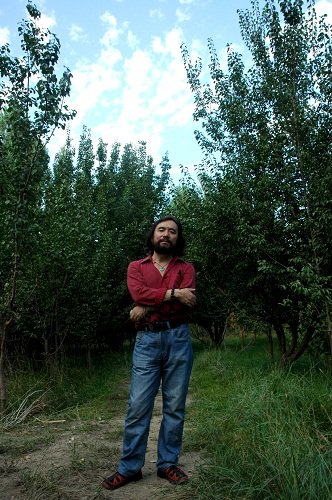
“Mahamudra: Essence and Practice”( Book II)
Let’s talk about vase breathing
◎Cheng Yixin: Would you be able to give introduction about vase breathing?
●Xue Mo: Shangpa-Kagyu tradition has two types of vase breathing, one is forceful and the other is gentle. One may apply the gentle vase breathing in daily life, which also known as “center-dwell breathing”, in Taoist practice it is called “abdominal breathing”. Under this breathing condition, one always needs to exert by bulging up the lower abdomen. Given proper training, the body will naturally maintain that breathing rhythm without losing track. After a while, one will adopt this breathing as a habit, subsequently reaches the state of qi penetrates central spiritual channel. Nevertheless, vase breathing practice requires lineage as well as close monitor of an attained teacher, lest one goes astray easily.
There are many advantages in practicing vase breathing; first of all it brings exceptionally good health. It is said that among all cultivation methods, vase breathing on navel chakra is the most beneficial to health. When there is persistent presence of purified energy in the navel chakra, it promotes one’s health and longevity. Regardless of whether it is Taoism or Buddhism, to keep at vase breathing is the key to longevity. When one keeps up training of the breathing technique, life will reach a harmonious state, with one’s immune system strengthens accordingly, moreover, one can also benefit from aspect of wisdom.
Vase breathing is the foundation to all teachings of Shangpa-Kagyu tradition, including illusory-body practice, kundalini practice, and luminosity practice. Padmasambhava said that all merits originate from vase breathing cultivation. Among former successive generations of Shangpu-Kagyu gurus, there are many that can keep at vase breathing for a long time.
In general, gentle vase breathing causes qi to exert downward with lower abdomen bulges out in force. The Taoist school had the saying “lower dantian endures fair strength”; this is somewhat similar to the condition of gentle vase breathing. If one keeps up with this state, then with increase of time, spiritual energy starts to gather in dantian (lower abdomen), after which the practice of kundalini becomes simple.
Shangpa-Kagyu cultivation calls for maintaining vase breathing even at time of sutra recitation. Traditionally, there is a particular method of breathing applied in the course of recitation, so that not only qi stagnation is avoided, it also fosters virtuous merits.
The aim of maintaining vase breathing is to achieve qi in central spiritual channel, follows by open up of spiritual channel block. After qi has penetrated the central spiritual channel, then with guru’s pointing out, one is able to see the true nature as would be expected,
It is certainly the most excellent if qualified practitioners has the opportunity to focus on vase breathing cultivation in secluded retreat. Nowadays, people lacking secluded retreat conditions may instead learn a few skillful means like triple-branch practices of Mahamudra (guru yoga, yidam deity yoga, illusory yoga). Skillful means like these allow one to practice while going about their daily lives, at which time what one sees are all perceived as guru’s transformation, the tea that one drinks is yidam deity’s amrita, when the wind blows it is the bestowal of yidam deity, hearing the bird’s warble is yidam deity’s crying sound……as one’s practice succeeded, one’s daily life would be rested in true wakefulness.
By that time, the bustling world in one’s eyes is projected as the pure land of Buddha.
Notice
Translated by non-professional volunteers, there would be some inaccuracies in the translation. You are welcome to offer us some advice for emendation. Please feel free to contact us.We also look forward to you joining our voluntary translation team.
Please contact us at suonanzhuoma1988@163.com, thank you.
《光明大手印:实修心髓》下
说说宝瓶气
◎陈亦新:您能不能介绍一下宝瓶气?
●雪漠:香巴噶举的宝瓶气有两种,一种是刚猛宝瓶气,一种是柔和宝瓶气。你可以在日常生活中持柔和宝瓶气,也叫“中住气”,在道教里面叫“气沉丹田”。在这种状态下,始终要用小腹鼓起来用力。当你训练有素时,身体就会自然而然地保任那种状态,不会丢失。天长日久,你就会形成一种习惯,进而气入中脉。不过,对宝瓶气的修炼,一定要有传承,得有善知识的亲自教授,不然,是很容易走偏的。
修宝瓶气有很多好处,首先是身体会非常好。据说,在所有的修行法门中,最有益于健康的是脐轮宝瓶气。当脐轮中经常会有真气存在的时候,可以让人健康长寿。无论道家也罢,佛教也罢,非常重要的长寿法就是持宝瓶气。当你经常持气训练有素时,生命就会达成一种和谐,你的免疫力也会相应增加,还可以得到其他智慧上的好处。
在香巴噶举教法中,宝瓶气是一切法的基础,包括修幻身、拙火、光明等都以此为基础。莲花生大士说,一切功德源于宝瓶气。过去历代的香巴噶举上师中,有很多人可以很长时间地持宝瓶气。
柔和宝瓶气一般要往下压气,小腹中鼓有力量。道家所说的“丹田长存三分力”,便有点像柔和宝瓶气。如果这种状态坚持下去,时间一长,丹田就会聚气,接下来修拙火,就会很容易。
在香巴噶举的修炼中,要求在诵经时也要持着宝瓶气。在传统的念诵过程中,有种特殊的持气修法,这样就不但不会伤气,还可以长养善功。
持宝瓶气的目的,是为了实现气入中脉,进而打开脉结。气入中脉之后,在上师的开示下,你就自然能够明白心性。
有条件的行者若有机会闭关,专修宝瓶气,当然是最好的。当代人在没有闭关条件时,也可以学习一些方便法门,比如大手印的三支法。这种方便法门能让你在做任何事情的时候,都可以修行。那时,你眼中一切的显现都是上师佛陀的化现,喝茶时是本尊的甘露,风吹时是本尊的加持,听到鸟鸣时是本尊的哭音……修成功时,你的行、住、坐、卧,都会安住于真正的觉性之中。
那时,你眼中的红尘,也就成了佛国净境。
声明:本文系文化志愿者试译,非专业人才翻译,错误定然不少,如出现疏漏及错误,敬请读者见谅。如有任何翻译上的建议及修正意见,欢迎及时与我们取得联系,我们会加以校对、修改,并希望有专业才能的朋友也能加入我们志愿者群体中来。
邮箱地址:suonanzhuoma1988@163.com
